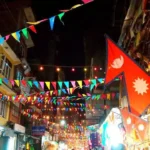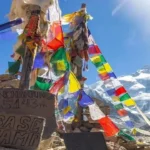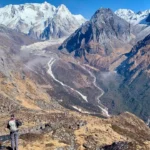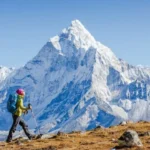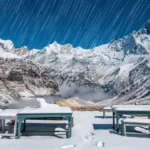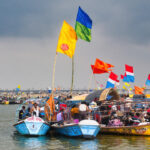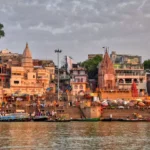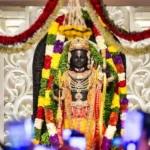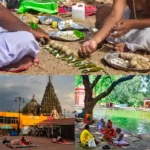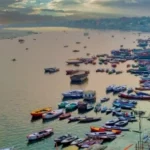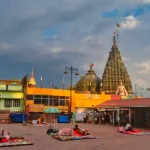The Heart of Kathmandu’s Spirituality: First Impressions and Setting
The journey to Swayambhunath often begins with the sight of its golden spire glinting in the sunlight from various points across Kathmandu. For the traditionalist or determined pilgrim, the path involves conquering the approximately 365 stone steps that lead directly up the hill’s eastern side. This ascent is a ritualistic climb, punctuated by smaller stupas, shrines, vendors selling religious artefacts, and the increasing presence of the site’s notorious monkey population. Each step upward offers expanding views of the valley below, building anticipation for the spiritual haven at the summit.
Upon reaching the top, via the stairs or the less strenuous vehicle road entrance on the southwest side, visitors are immediately immersed in an atmosphere thick with devotion and history. The air hums with activity – the clatter of prayer wheels being spun clockwise, the murmur of prayers, the sharp calls of monkeys, and the gentle tinkling of bells.
The sheer scale of the main stupa, brilliant white against the blue sky, is breathtaking. Known as ‘Swayambhu’, meaning ‘self-sprung’ or ‘self-arisen’ in Sanskrit, the name itself hints at the site’s mythical origins, suggesting a divine presence that manifested on its own, long before human hands shaped its physical form. This hilltop sanctuary serves not only as a major pilgrimage site for Buddhists from around the world but also as a central point of cultural and spiritual life for the people of Kathmandu. It’s a place where the sacred and the everyday intertwine, visited by devout monks and nuns, local families, and international tourists side-by-side.
A Tapestry of History and Legend: Unearthing the Past
The story of Swayambhunath is deeply intertwined with the very origins of the Kathmandu Valley itself, beginning in the realm of mythology before transitioning into recorded history.
The Mythological Origins: The most famous legend tells of a time when the Kathmandu Valley was a vast, primordial lake. From the depths of this lake bloomed a magnificent lotus flower, radiating a brilliant, self-arisen light – the ‘Swayambhu’ light. It was prophesied that this light represented the essence of all Buddhas. Hearing of this miraculous light, Manjushri, the bodhisattva of wisdom, travelled from China. Seeing the potential for human habitation and easier access to this sacred light, he used his sword to cut a gorge in the surrounding hills (identified as the Chobar gorge), draining the lake.
As the waters receded, the lotus flower settled on a hilltop, and the light transformed into the stupa that stands there today. This act made the valley habitable and brought the sacred site within reach of mortals, establishing Swayambhunath as a place of profound spiritual power and marking the beginning of human civilisation in the Kathmandu Valley. Another charming legend connects the site’s monkey inhabitants to Manjushri; it is said that the monkeys are descendants of lice that infested Manjushri’s hair, which he allowed to fall upon the hill.

Historical Development: While the precise date of the first structure at Swayambhunath is debated, its antiquity is undeniable. Some historical accounts suggest the site was already an important Buddhist pilgrimage destination by the 5th century CE, during the Lichhavi dynasty. The Licchavi king Vrisadeva is credited with building a stupa here around that time. Later, the site was further developed and expanded under the Malla kings of Kathmandu Valley.
Subsequent centuries saw the addition of numerous monasteries, temples, statues, and other religious structures by various rulers, monks, and wealthy patrons, reflecting the growing importance of Swayambhunath as a centre of Buddhist learning and worship. The iconic white dome and golden spire have been renovated and rebuilt over time, particularly after damage from earthquakes and other natural events, most notably after the devastating 2015 earthquake. Despite these challenges, the core sacredness and form of the stupa have been preserved through continuous devotion and reconstruction efforts. Swayambhunath’s history is not just one of construction but also resilience and continuity of faith across generations.
Syncretism: The Blend of Buddhism and Hinduism: One of the most fascinating aspects of Swayambhunath, and indeed of many sacred sites in Nepal, is the harmonious co-existence and intermingling of Buddhist and Hindu practices. While primarily a Buddhist site, Swayambhunath is deeply revered by Hindus as well. They often worship the stupa itself as a manifestation of the Adi-Buddha (the primordial Buddha) or identify aspects of the complex with Hindu deities.
A prominent example is the Hariti Ajima Temple within the complex. Hariti was originally a demoness who abducted children but was reformed by the Buddha and became a protector deity, particularly of children and health. In the Newar tradition of Kathmandu Valley, Hariti is worshipped by both Buddhists and Hindus (where she is sometimes identified with the goddess Ajima or Sitala, associated with smallpox and disease). Devotees from both faiths visit her temple seeking blessings for their children. This shared devotion reflects the unique syncretic culture of Nepal, where religious boundaries are often fluid, and deities are revered across different traditions, highlighting a long history of peaceful coexistence and mutual respect.
Decoding the Symbols: Architecture and Meaning
The architecture of Swayambhunath Stupa is laden with profound symbolism, with each element representing a crucial aspect of the Buddhist path to enlightenment. Understanding these symbols enriches the visitor’s experience and reveals the deep spiritual significance of the site.
The Stupa’s Structure Explained:
- The Base: The large, whitewashed hemispherical dome rests on a circular base, which is often interpreted as a mandala. A mandala is a cosmic diagram representing the universe. Circumambulating the base clockwise is a form of meditation and prayer, symbolically journeying around the universe and accumulating merit.
- The Dome (Garbha): The solid hemisphere itself represents the vastness of the earth and the universe, the foundation upon which spiritual progress is built. It is also seen as the ‘garbha’ or womb, symbolising the potential for enlightenment inherent within all beings. The pristine white colour signifies purity.
- The Harmika: This square structure sits directly atop the dome. It is arguably the most iconic part of Swayambhunath due to what it bears:
- The Eyes of the Buddha: Painted on all four sides of the Harmika, these are the famous, all-seeing eyes of the Buddha. They symbolise the Buddha’s omniscience and omnipresence, compassionately watching over all sentient beings in all four directions, guiding them towards salvation. The distinct curly symbol resembling a nose between the eyes is the Nepali character for ‘one’ (एक, ek), representing the unity of all things and the single path to enlightenment, or the nose of the Buddha emitting the fragrance of liberation. The dot above the nose represents the ‘urna’, the tuft of hair between the Buddha’s eyebrows, symbolising the third eye, representing wisdom and insight.
- The Thirteen Tiers/Rings: Above the Harmika rises a conical spire made up of thirteen gilded rings or tiers. Each ring represents one of the thirteen stages a bodhisattva must traverse to achieve full Buddhahood – a symbolic ladder leading towards enlightenment.
- The Umbrella (Chhatra): Crowning the spire is a beautiful golden umbrella. In many Asian cultures, the umbrella is a symbol of royalty and protection. Here, it signifies the protection of the dharma (Buddhist teachings) and the Buddha’s royal status as the spiritual king.
- The Pinnacle (Gajur): At the very peak, the spire culminates in a golden pinnacle, often adorned with precious stones. This represents Nirvana, the state of ultimate liberation and enlightenment, the final goal of the Buddhist path.

Other Structures and Symbols within the Complex:
- Prayer Wheels: Rows of large metal cylinders surround the base of the stupa and line pathways. Inscribed with the mantra “Om Mani Padme Hum,” spinning these wheels clockwise is considered equivalent to reciting the mantra aloud, generating positive karma and accumulating merit. The act of spinning is a form of active meditation and prayer.
- Prayer Flags: Vibrant strings of prayer flags (Lungta) are strung across the complex, connecting stupas, trees, and buildings. The five colours – blue, white, red, green, and yellow – represent the five elements (space, air/wind, fire, water, and earth, respectively). Printed with prayers, mantras, and symbols, the flags release these spiritual messages on the wind, carrying blessings to all beings.
- Monasteries and Temples: The complex is home to several monasteries (Gompas) representing different schools of Tibetan Buddhism, as well as Hindu shrines. Notable ones include the temples of Pratappur and Anantapur (built by King Pratap Malla), and the vital Hariti Ajima Temple. These offer diverse architectural styles and spaces for worship and contemplation.
- Statues: Numerous statues dot the complex, including various manifestations of the Buddha, Bodhisattvas like Manjushri, and other deities revered in both Buddhist and Hindu pantheons. These statues serve as focal points for prayer and offerings.
- Vajra: At the top of the main eastern staircase sits a massive double Vajra (Dorje in Tibetan), a symbol of indestructibility, spiritual power, and the union of compassion and wisdom. Devotees often touch or walk around it for blessings.









